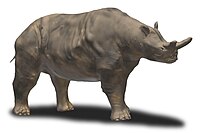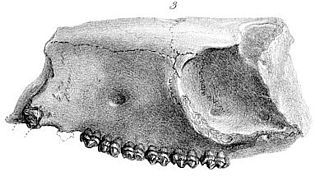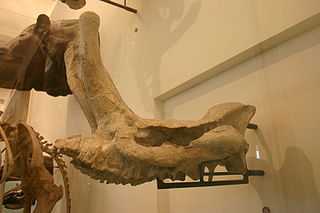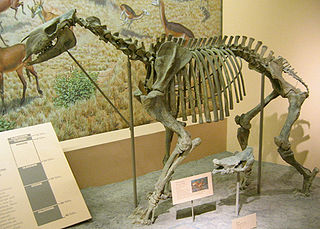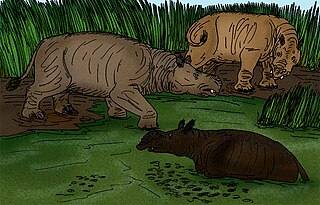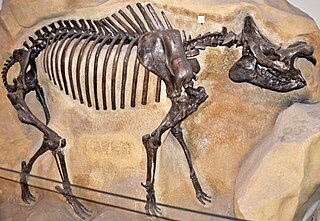- Family Brontotheriidae
- Pakotitanops incertae sedis , from Pakistan
- Nanotitanops incertae sedis , from Asia
- Subfamily Lambdotheriinae
- Subfamily Palaeosyopinae
- Subfamily Dolichorhininae
- Subfamily Brontotheriinae
- Subfamily Embolotheriinae
- Subfamily Brontopinae
- Brachydiastematherium , from Eastern Europe, 2 m tall
- Pachytitan , from Inner Mongolia, 2 m tall
- Dianotitan , from China, 2 m tall
- Gnathotitan , from Inner Mongolia, 2.5 m tall
- Microtitan , from Inner Mongolia, 0.75 m tall
- Epimanteoceras , from Inner Mongolia, 2 m tall
- Protitan , from Inner Mongolia, 2 m tall
- Rhinotitan , from Inner Mongolia, 2.5 m tall
- Metatitan , from Mongolia, 1.5 m tall
- Protitanotherium , from North America, 2 m tall
- Parabrontops , from Mongolia, 2 m tall
- Oreinotherium , from North America
- Brontops , from North America
- Protitanops , from North America, 2 m tall
- Pygmaetitan , from China, 0.5 m tall
- Subfamily Telmatheriinae
- Acrotitan , from Inner Mongolia, 0.3 m tall
- Desmatotitan , from Inner Mongolia, 1.25 m tall
- Arctotitan , from China
- Hyotitan , from Inner Mongolia, 2.2 m tall
- Sthenodectes , from North America, 1.25 m tall
- Telmatherium (including Metatelmatherium), from North America and Inner Mongolia, 1.5 m tall
- Sivatitanops , from Asia and Europe
- Subfamily Menodontinae
| - Family Brontotheriidae
- Pakotitanops incertae sedis , from Pakistan
- Mulkrajanops incertae sedis , from India, 1.25 m tall
- Eotitanops , from North America, 0.5 m tall
- Palaeosyops , from North America, 1 m tall
- Subfamily Brontotheriinae
- Bunobrontops , from Asia
- Mesatirhinus , from North America, 1 m tall
- Dolichorhinus , from North America, 1.25 m tall
- Sphenocoelus , from North America, 1.25 m tall
- Desmatotitan , from Inner Mongolia, 1.25 m tall
- Fossendorhinus , from North America
- Metarhinus , from North America, 1 m tall
- Microtitan , from Inner Mongolia, 0.75 m tall
- Sthenodectes , from North America, 1.25 m tall
- Telmatherium , from North America, 1.25 m tall
- Metatelmatherium , from North America and Inner Mongolia, 1.25 m tall
- Epimanteoceras , from Inner Mongolia, 2 m tall
- Hyotitan incertae sedis , from Inner Mongolia, 2.2 m tall
- Nanotitanops incertae sedis , from Asia
- Pygmaetitan incertae sedis , from China, 0.5 m tall
- Acrotitan incertae sedis , from Inner Mongolia, 0.3 m tall
- Arctotitan incertae sedis , from China
- Qufutitan incertae sedis , from China
- Tribe Brontotheriini
- Protitan , from Inner Mongolia, 2 m tall
- Protitanotherium , from North America, 2 m tall
- Rhinotitan , from Inner Mongolia, 2.5 m tall
- Diplacodon (including Eotitanotherium), from North America, 2 m tall
- Pachytitan , from Inner Mongolia, 2 m tall
- Brachydiastematherium , from Eastern Europe, 2 m tall
- Sivatitanops , from Asia and Europe
- Subtribe Embolotheriina
- Gnathotitan , from Inner Mongolia, 2.5 m tall
- Aktautitan , from Kazakhstan, 2.5 m tall
- Metatitan , from Mongolia, 1.5 m tall
- Nasamplus , from Inner Mongolia
- Protembolotherium , from Outer Mongolia, 2 m tall
- Embolotherium (including Titanodectes), from Mongolia, 2.5 m tall
- Subtribe Brontotheriina
- Parabrontops , from Mongolia, 2 m tall
- Protitanops , from North America, 2 m tall
- Notiotitanops , from North America, 2 m tall
- Dianotitan , from China, 2 m tall
- Duchesneodus , from North America
- Megacerops (including Menodus, Brontotherium, Brontops, Menops, Titanotherium, Ateleodon, and Oreinotherium), from North America, 2.5 m tall
|

